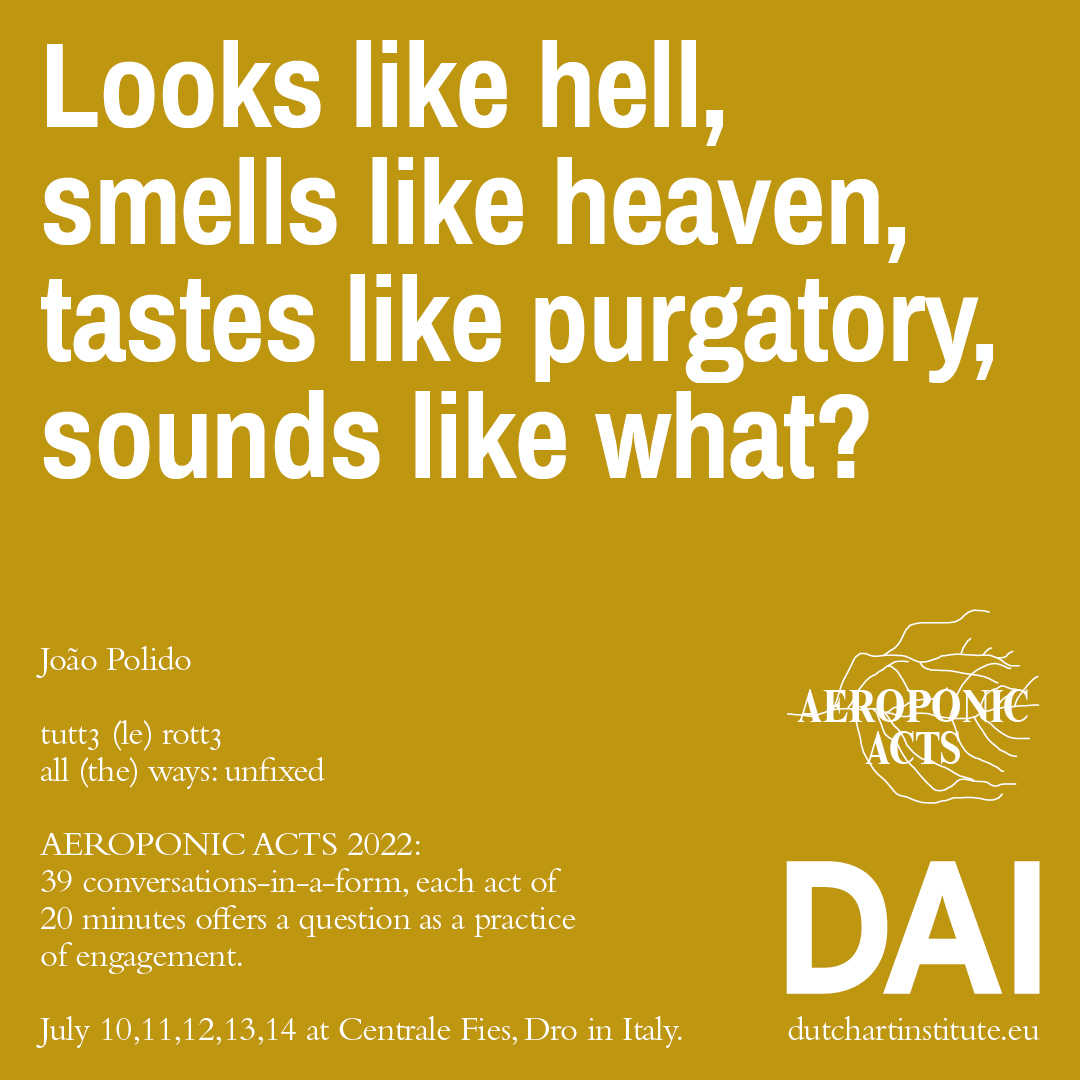João Polido: Hearing Smoke
‘Aeroponic’ – root systems nourished by air – Acts is the name given to the nomadic Dutch Art Institute’s final Kitchen presentations. Each participant addresses one question, as a practice of engagement.
Here you will find the documentation of João Polido's presentation as filmed by Baha Görkem Yalım. The written report is by Hubert Gromny and it includes a summary of the comments by esteemed guest respondents.
Hearing smoke
João's question: Looks like hell, smells like heaven, tastes like purgatory, sounds like what?
João's introduction: The dream that leads to an eventual actual noise that wakens the dreamer.
Hubert's report: The audience enters a room in a stage setting. In the darkness, there is only one spotlight revealing a ceremonial vase placed on the floor of the stage. The room is silent while the red dim lights illuminate another place where three microphones on stands are pointing at the speakers hanging from the ceiling. A sudden and elusive spark of fire in the back of the stage discloses the presence of João, who lightens up a few incense sticks. Faint lights of incense sticks and sound of chimes marks his movement through the stage. Another spotlight, soft-yellow, reveals the third element of the installation in a shape of two drawings hanging in the space. João places incense in the vase and reaches the table with sound equipment located in the dark. Eerie sound fills the space. The volume of the audio increases with sounds resembling starting an engine, chirping of crickets and revolving rotors of a helicopter. The musical samples of string instruments, guitars, and choirs are intertwined with droning noises and quotidian sounds with distinctive presence of clinking and jingling of metal elements, as if somebody would search for a key in a toolbox. Samples of captivating melodic structures evoke vernacular music traditions, which encounter orchestral and symphonic recordings in later parts of the piece. As the audio piece acquires a thick density of various sonic textures, João leaves the table and engages with the installation, dismantling it partly. The stage is rhythmically illuminated with red lights, speeding of which creates a stroboscopic effect. João disappears from the stage and the sound continues to be present, shifting toward more distorted shapes. The sound stops suddenly marking the end of the performance.
Chiara Figone was touched by the creation of the undefined space, where shapes and contours were blurred and visibility limited. She noted that it is not possible to immediately decipher the piece, but she was able to experience the presence of different codes and layers in the piece. As such the piece was interestingly building a sonic space of resilience and juxtaposition where different worlds seemed to collide and create a form of storytelling. This type of sonic storytelling has a capacity to move one's body away from how we usually receive and tell histories. Chiara commented also on the plurisensual character of the space, where sound, smell and sight were involved in creating an experience of time travel in the form of sonic storytelling.
Phanuel Antwi proposed to think of a piece through a title for a potential text “Unbeing Moved”. He referred to the title of the presentation “Hearing Smoke” as a point of departure/arrival to think of accessibility. The piece is committed to accessibility as it offers a way to challenge the normativity of how senses are activated by society. Hearing smoke allows for the piece to be available to those for whom it is difficult to hear the sound. Activation of vision, smell allows to say the same about other senses. As such the piece has a profound meaning and accessibility becomes a matter of more than just sense but is a matter of life and death. The moment of stroboscopic red lights felt like a call for waking. Phanuel noted however that use of strobe lights need a warning, as they can activate reactions potentially dangerous for some members of the audience. At the end of his response Phanuel commented on the feeling of transportation created by the piece. Referring to literary traditions of the romantic period, which offered imaginative participation in the scenes evoked and through that allowing physical transportation and movement.
Momtaza Mehri picked up on Phanuel’s comment about movement and transportation. She also noted that the presence of incense and silence at the beginning of the piece was alluding to the presence of something dead and had a destabilizing effect which worked in a very profound way. Momtaza dwelled into the use of incense for mystic and domestic practices in various cultures such as Egypt, Mesopotamia or India, and shared that for her, the use of incense is associated with expulsion of something. In the Horn of Africa, incense is used especially by women to renew and refresh themselves, or purge the residue of a previous year. From another angle, Momtaza commented on a triangle of microphones seemingly referring to a compulsion of speech. She closed her response by noting that the combination of melancholic guitar samples, piano tones and industrial clangs, provided an interesting contrast between the machinery of senses and the transient character of the smoke.
About: João Polido
João Polido's "Hearing smoke" was presented before live audience at the Centrale Fies, Dro, Italy on July 12th.
Find the overview of all 24 AEROPONIC ACTS 2022 here: tuttə (le) rottə - all (the) ways: unfixed


